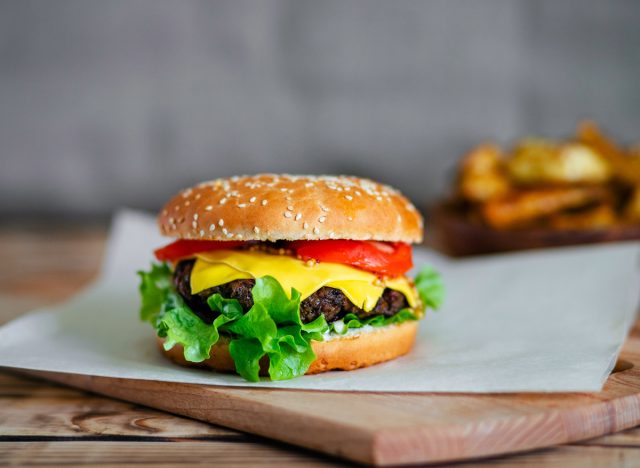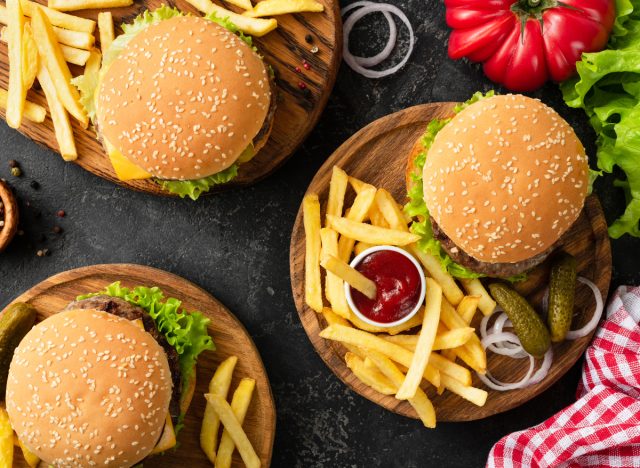Trying to lose weight is a challenge in and of itself. One of the most important first steps is to reevaluate your diet and potentially eliminate (or cut back on) some of the more indulgent foods you love most. For instance, if cheeseburgers are one of your favorite meals to splurge on, you’re likely wondering, “How many calories are in a cheeseburger?” and, “Can I treat myself to a cheeseburger? I’ve been eating sensibly this whole week!”
When it comes to cheeseburgers and toppings, there are so many to choose from. If you’re a McDonald’s fan, you can choose from a Quarter Pounder® with cheese, a Double Quarter Pounder® with cheese, a Double Cheeseburger, and more. Or if you’re on team Burger King, you can purchase a Single Quarter Pound King, the Bacon Cheeseburger, and more. All of these burger delights from your go-to fast food joint or restaurant range in calorie counts, burger size, and toppings. Some common cheeseburger topping favorites include cheese, lettuce, tomato, onions, ketchup, and pickles. You can really go ham and get as creative as you’d like.
Whatever your burger masterpiece of choice may be, Eat This, Not That! has the scoop. We spoke with Amy Goodson, MS, RD, CSSD, LD, a registered dietitian and certified specialist in sports dietetics who sits on our Medical Expert Board, who reveals whether you can safely work a cheeseburger into a well-balanced diet. Keep reading to learn more, and when you’re finished, be sure to check out the 10 Best Costco Frozen Foods for Weight Loss.
Cheeseburger calorie breakdown:

How many calories are in a cheeseburger? Let’s break it down.
- ¼ Pound Patty: 231 calories
- American Cheese: 80 calories
- Bun: 240 calories
- Additional Toppings:
- Condiment Options:
- Total Calorie Count (burger, American cheese, toppings, and ketchup): 585 calories
Factors affecting calorie content:
As previously stated, not all cheeseburgers are created equally. If you are going to indulge, it’s necessary to know what you’re getting yourself into. For example, think about portion size (single versus double) and whether or not you want to spend calories on a bun. Brioche buns, sweet buns, and potato rolls all vary in calories. Lastly, toppings can add a ton of excess calories to your cheeseburger; eliminating them can possibly save you from a horrific final count.
What is the recommended daily calorie intake for healthy adults?
As far as the recommended daily calorie count for healthy adults is concerned, Goodson tells us, “The Dietary Guidelines for Americans base nutrition recommendations for Americans on a 2,000-calorie diet. This is what nutrition facts labels on foods are referencing when they list Daily Values and percentages. For example, if a food label has 6% next to fat; then that means that one serving of that food provides 6% of your fat needs based on a 2,000-calorie diet.”
The challenge here lies in the fact that these guidelines are curated for the general population and don’t take into consideration an individual’s weight loss goals or weight gain, their weight and height, fitness level, etc., Goodson points out. It’s simply a general recommendation.
The fact of the matter is, you can easily rack up close to 2,000 calories with one packed burger. That’s why it’s so important to choose your ingredients wisely.
Can you eat a cheeseburger when following a well-balanced diet?

Get excited, because Goodson confirms you can absolutely enjoy a cheeseburger while following a well-balanced diet. It really all depends on how you dress your burger—and enjoying it in moderation. This may, in fact, help you stick with a diet in the long run by treating yourself to the occasional burger.
“Lean beef provides 10 essential nutrients including high-quality protein, iron, zinc, vitamin B12, the antioxidant selenium, and more,” Goodson says. “To be classified as ‘lean,’ that means that a 3.5-ounce serving contains 10 grams of fat and 4.5 grams of saturated fat or less. So, choosing beef that is 92% lean or leaner qualifies! The key is the leanness and the serving size, and of course what you layer on the burger.”
Here’s how to make a cheeseburger healthier.
There are many different ways to make a cheeseburger healthier, whether you’re whipping one up at home or ordering one at a restaurant.
Making a cheeseburger at home:
A burger can actually be healthy if you include all of the food groups in it. For instance, Goodson suggests choosing a whole grain hamburger bun (grain), lean ground beef patty (protein), a 2% slice of cheese (dairy), lettuce, tomato, onions, and other veggies (vegetables), along with mashed avocado for the spread (fruit). This can make a major difference in calories and nutrition. Being mindful of any sauces you include can make or break a balanced meal.
The best part? You can really get creative! “Try grilling vegetables like onions, mushrooms, and colorful peppers,” Goodson suggests. “You can even add grilled fruit to burgers like pineapple and peaches. Then try other spreads like hummus and yogurt-based blue cheese or ranch spreads.”
Another area where you can let your creativity shine is with the “bun.” “If you are looking to cut back on extra calories, go with a lettuce wrap or an open-face bun and just eat one side of it,” Goodson says. “Or try a ‘sandwich thin’ as the burger base.” Every calorie counts!
Ordering a cheeseburger out:
There are certain useful strategies to follow when you’re ordering out, which are pretty similar to preparing a cheeseburger at home.
Goodson warns, “Where most people get in trouble with burgers, restaurants, and fast-food drive-thrus is with the serving size and toppings. Eating two (or three!) patties, layering it with multiple slices of cheese and bacon, lathering it with mayo, ranch, or other creamy sauces, and then topping it with crispy onion strings, onion rings, or the like can take a burger to a calorie catastrophe quick!”
The bottom line is that you can order a cheeseburger—you just may have to do some healthy swaps or special orders. Goodson suggests choosing a lettuce wrap and a single normal-sized patty. In addition, ditch the onion rings, bacon, cheese sauce, or other creamy sauces.

